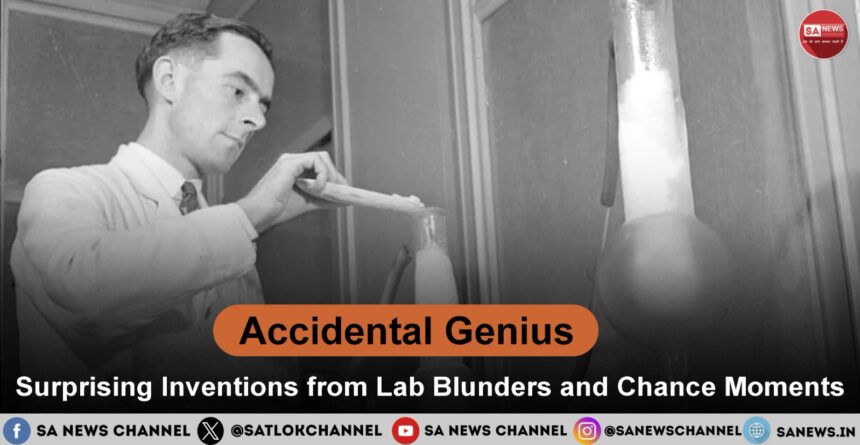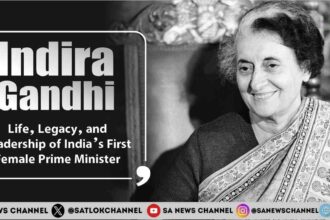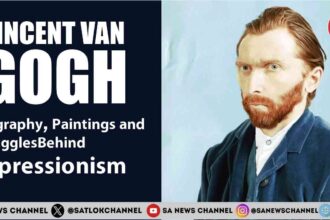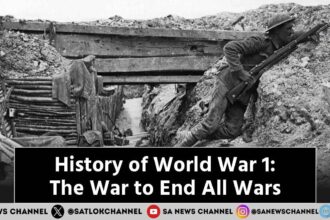Accidental Genius: What if the glue that holds your notes together or the medicine that fights infections started as a frustrating failure? History shows that many everyday items came from accidental inventions. These unexpected discoveries often happened when scientists faced setbacks or noticed odd side effects. For instance, a melted chocolate bar led to a kitchen appliance we cannot imagine life without. This blog chronicles seven such stories. Each one highlights the human side: curious minds turning mistakes into breakthroughs.
- The Mold That Saved Millions: Penicillin’s Chance Find
- A Melted Treat Sparks Kitchen Magic: The Microwave Oven
- Sticky Solution from a Slippery Adhesive: Post-it Notes
- Bonded by Frustration: Super Glue’s Stubborn Stick
- Shadows on a Screen: X-rays’ Eerie Reveal
- A Forgotten Drink Turns into Summer Fun: The Popsicle’s Icy Surprise
- Flaky Wheat to Breakfast Staple: Corn Flakes’ Sanitarium Surprise
- Beyond Chance: Finding Meaning in the Unexpected
From overworked researchers to eager experimenters, these tales remind us that innovation sometimes needs a nudge from chance. We draw from trusted sources like the American Chemical Society and the Lemelson-MIT Program to share accurate details. Explore how serendipity shaped products from antibiotics to adhesives.
The Mold That Saved Millions: Penicillin’s Chance Find
In 1928, Alexander Fleming, a Scottish bacteriologist at St. Mary’s Hospital in London, returned from a two-week vacation to his cluttered lab. As a professor of bacteriology, Fleming studied bacteria like Staphylococcus, which caused deadly infections. He sorted through petri dishes left with bacterial cultures. One dish caught his eye. A blob of mold had contaminated it, creating a clear zone around itself where bacteria refused to grow. This mold, later identified as Penicillium notatum, produced a substance that killed harmful bacteria such as streptococcus and diphtheria bacillus.
Fleming, known for his keen observation, tested the “mold juice.” It showed promise against infections, but isolating the pure compound proved tough. His assistants, Stuart Craddock and Frederick Ridley, worked on it, yet the substance stayed unstable, yielding only weak solutions. In June 1929, Fleming published his findings in the British Journal of Experimental Pathology. He focused on its use to separate bacteria types in labs, mentioning therapy only in passing. The scientific community took little notice at first.
Ten years later, in 1939, Howard Florey and Ernst Chain at Oxford University revived the work amid World War II’s urgent need for infection treatments. Florey, an Australian pathologist, led a team facing wartime shortages. They grew the mold in makeshift vessels like bedpans and milk churns, producing up to 500 liters of filtrate weekly. Norman Heatley, a biochemist, extracted the compound using amyl acetate. Edward Abraham purified it further.
Their first human test came in 1941. Policeman Albert Alexander, 43, suffered a severe infection from a rose-pruning scratch. Abscesses swelled his face, eyes, and lungs. After the injection on February 12, he improved dramatically, talking and eating within days. Supplies ran out, and he died, but later patients fared better. Florey and Heatley traveled to the U.S. in 1941 to help scale production. At the Northern Regional Research Laboratory in Peoria, Illinois, Andrew Moyer boosted yields tenfold by adding corn-steep liquor to the mix.
U.S. companies like Pfizer ramped up efforts. By 1943, production hit billions of units, dropping prices sharply. Penicillin treated wounds, syphilis, and more, aiding D-Day troops. Fleming, Florey, and Chain shared the 1945 Nobel Prize. Fleming’s accidental spotting of mold changed medicine forever, saving countless lives from bacterial threats. This unexpected discovery shows how one overlooked petri dish sparked a global health revolution.
A Melted Treat Sparks Kitchen Magic: The Microwave Oven
Percy Spencer grew up in rural Maine, born on July 9, 1894. He left grammar school at age 12 to work in a weaving mill, showing early curiosity about machines. At 18, he joined the U.S. Navy as a radio operator during World War I. There, Spencer taught himself calculus and physics from books. After discharge, he joined Raytheon Manufacturing Company, rising to lead radio and vacuum tube development. During World War II, his team mass-produced the cavity magnetron, a tube generating microwaves for radar to spot enemy planes and submarines. For this, he earned the U.S. Navy’s Distinguished Public Service Award.
In 1945, postwar lab work brought a surprise. Spencer stood near a magnetron when he felt a strange warmth. Reaching into his pocket, he found his chocolate bar melted into a gooey mess. Puzzled, the self-taught engineer wondered if microwaves caused it. He tested by placing an unpopped bag of popcorn nearby. Kernels burst into fluffy white clouds, confirming the effect. Spencer shared the find with colleagues, who saw potential beyond radar.
Raytheon invested in development. Spencer filed a patent on October 8, 1945, granted January 24, 1950. They built the first commercial model, the “Radarange,” in 1907. It stood six feet tall, weighed 750 pounds, and cost $3,000, aimed at restaurants and hotels. Early users boiled water or cooked eggs, though one test exploded eggs, prompting safety rules. Spencer refined designs, shrinking size and cost over years.
By the 1950s, home models appeared, revolutionizing cooking. Spencer’s accidental melt led to faster meal prep worldwide. His story highlights persistence: from mill boy to inventor, turning a pocket mishap into a household staple. Today, microwaves save time for busy families, all from one curious engineer’s warm surprise.
Sticky Solution from a Slippery Adhesive: Post-it Notes
At 3M Company in 1968, chemist Spencer Silver tackled a tough task: create a super-strong adhesive for industrial use. Instead, he mixed tiny acrylic spheres into a formula that stuck lightly and peeled off without residue, reusable many times. Silver called it a “solution to a non-problem” but shared it through company seminars, hoping for ideas.
Four years later, Art Fry, a chemical engineer and church choir member, attended a Silver seminar. Fry struggled with bookmarks slipping from his hymnal during services. The weak adhesive clicked: it could anchor paper temporarily. He sketched a reusable bookmark idea and pitched it to supervisors. They worried about waste but tested prototypes after staff buzz grew.
Development took five more years. Fry coated paper with Silver’s glue on one edge, cut into pads, and named them “Post-it Notes.” Early trials in 3M offices showed demand, but national launch stalled over color and size doubts. In 1977, a Boise, Idaho, test run succeeded, leading to 1980 nationwide release. Offices, schools, and homes adopted them quickly for reminders and brainstorming.
Silver and Fry’s collaboration turned failure into fortune. Silver, patient in promoting his odd glue, paired with Fry’s everyday frustration. Their story shows how accidental inventions thrive on teamwork. Post-it Notes now aid productivity globally, proving weak bonds can hold ideas strong.
Bonded by Frustration: Super Glue’s Stubborn Stick
During World War II, chemist Harry Coover at Eastman Kodak sought clear plastic for gun sights. In 1942, his cyanoacrylate compound stuck to everything, ruining experiments. Frustrated, Coover shelved it as useless.
Nine years later, in 1951, Coover revisited cyanoacrylate for heat-resistant jet canopies. Again, its extreme bonding caused issues, gluing tools permanently. This time, he saw value: it joined materials without heat or pressure, stronger than many adhesives. Coover and colleague Fred Joyner refined it, testing on metals and plastics.
Eastman Kodak marketed it as Eastman 910 in 1958, the first commercial super glue. It bonded in seconds, ideal for quick repairs. Demand grew in hobbies, medicine for wound closure, and industry. Coover, reflecting on the shift, noted how initial annoyance became a career highlight.
Super glue’s path from wartime flop to household hero underscores resilience. Coover’s persistence transformed a lab nuisance into a fix-it essential, mending everything from models to accidents.
Shadows on a Screen: X-rays’ Eerie Reveal
On November 8, 1895, German physicist Wilhelm Conrad Röntgen worked alone in his Würzburg lab. He studied cathode rays in a vacuum tube, noticing they produced a glow on a nearby fluorescent screen coated in barium platinocyanide. Wrapping the tube in black paper to block light, he saw the glow persist, meaning rays passed through materials.
Curious, Röntgen placed objects between the tube and screen. A lead disc cast a sharp shadow. Then, he put his hand in the path. To his shock, he saw bones outlined against soft tissue on the glowing screen. He called the rays “X-rays” for their unknown nature.
Röntgen photographed his wife’s hand, producing the first medical X-ray image. News spread fast; he won the 1901 Nobel Prize in Physics. This accidental glow changed diagnostics, allowing non-invasive bone views.
Röntgen’s late-night solitude and sharp eye turned mystery into medicine. His discovery, born from an unintended leak, revolutionised healthcare, spotting fractures without cuts.
A Forgotten Drink Turns into Summer Fun: The Popsicle’s Icy Surprise
In 1905, an 11-year-old boy named Frank Epperson lived in Oakland, California. One winter evening, he mixed water with powdered soda to make a fizzy drink. He stirred it with a wooden stick and set the glass on the porch before going to bed. That night turned unusually cold, and the mixture froze solid around the stick.
The next morning, Frank discovered the frozen treat. He pulled the stick out and licked the icy soda. He found it tasty and refreshing. Excited, he shared it with friends and family, calling it an “Epsicle” after his name. For years, he made more on cold days, refining flavours like orange and lemon.
At age 29 in 1923, Epperson patented his creation as a “frozen confection of flavoured liquid on a stick.” He started a small business, selling them at parks and beaches. In the late 1920s, he sold the rights to Joe Lowe, who turned it into the popular Popsicle brand with dual flavours on one stick.
Epperson’s simple childhood mistake brought joy to kids everywhere. His story shows how a young person’s curiosity can create a beloved treat that cools hot days and sparks smiles.
Flaky Wheat to Breakfast Staple: Corn Flakes’ Sanitarium Surprise
In 1894, brothers Dr. John Harvey Kellogg and Will Keith Kellogg ran the Battle Creek Sanitarium in Michigan. As health reformers, they created simple, vegetarian foods for patients seeking wellness. One day, Will boiled wheat for granulation but left it out overnight. It went stale and gummy.
Instead of tossing it, Will rolled and baked the flakes. Patients loved the light, crunchy result. The brothers experimented, switching to corn for better texture. This became flaked corn cereal.
John focused on medicine, but Will saw business potential. In 1906, he founded the Kellogg Company, selling Toasted Corn Flakes. Toll-free recipes boosted sales.
The Kelloggs’ thrift turned oversight into routine. Will’s initiative built an empire, making morning flakes a healthy habit worldwide.
Beyond Chance: Finding Meaning in the Unexpected
The stories of accidental inventions show how small, ordinary moments can reshape the world, suggesting that life often moves through patterns we do not fully see. When a simple oversight leads to healing, comfort or new possibilities, it quietly reminds us that deeper purpose may guide events even when we assume randomness. This sense of hidden order naturally opens the door to questions about our own direction, inner clarity and the source of wisdom that steadies us. Readers interested in exploring these deeper layers of life may find thoughtful guidance in “Gyan Ganga” and “Way of Living” by Saint Rampal Ji Maharaj, which offer reflections on meaningful living and sincere worship.









